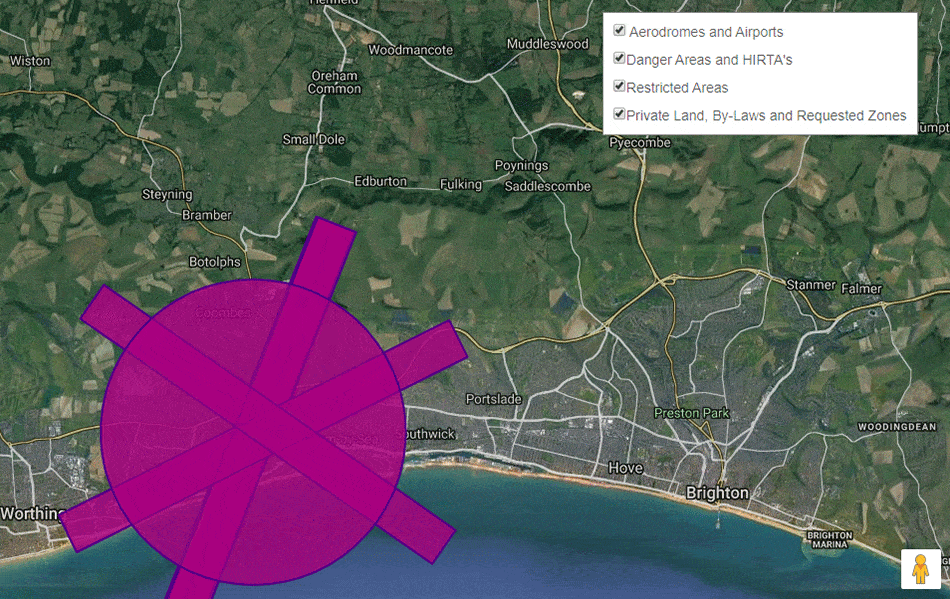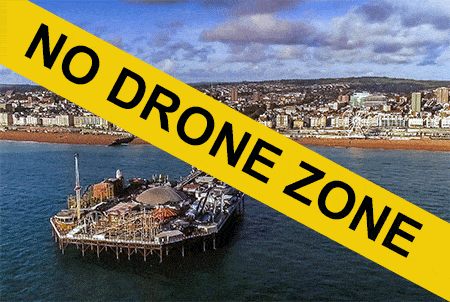Flying drones have become immensely popular over the last two decades. Drone video and drone footage are today commonplace both in the private and in the commercial sphere. Safety concerns, however, have brought increased regulation and in many places flying drones is no longer allowed.
So, what about flying a drone in Brighton? Yes, you are technically allowed to fly a drone in Brighton. However, the limitations placed on drone usage by Civil Aviation Authority make flying a drone in Brighton very challenging. Starting at the end of November 2019 you will also need to both registers your drone and sit a safety test to fly it.
The regulations have changed so that flying a drone is a little bit like having a small aeroplane. There are many hoops to go through and in the end, the practical limitations can seem very harsh. In this post, we will go over these rules and how they apply to drones in Brighton.
Drones, Brighton, and the Law
Drones have gone from super-specialized military applications to £10 plastic toys in a fairly short time.
The drones, particularly the quad-copters and variants, emerged from total obscurity as the electronics needed to make them became a lot cheaper. Gyroscopes, GPS receivers, motors, and controllers all saw a significant reduction in price at about the same time.
The drones became a household item and calamity ensued. After several much-publicized incidents at Airports, the UK government changed legislation to adapt to the new situation with drones. People being filmed by drones without their consent was also a big concern.
Drones, being essentially unregulated in the beginning, are now subject to quite a few regulations to own and fly. This is followed by even more limits on where they can actually flow.
Starting with the permits. At the time of writing, there are no direct limits on the ownership of a drone under 20kg in weight and there are no necessary licenses you need to have. This will change in November 2019, we will cover this below. You are responsible for your drone and for flying it safely but that is about it.
Actually flying a drone, however, is covered by many static and dynamic limitations. Check out this amazing Areal video by Site Flyt
Static Limitations on Drones
- Cannot fly higher than 122m(400 ft)
- Cannot fly within 5km of an airport
- Cannot fly in any no-fly zones (military)
- Cannot fly within 1 km of prisons
- Cannot drop things from your drone
- Need a special permit and insurance if you fly commercially
- The drone cannot weigh more than 20kg
- Drones have to be in sight of the operator
These limitations do not change. If you keep away from the restricted airspaces, do not operate the drone commercially and do not do dangerous things like dropping stuff, you will be fine. You can study maps and find out where the restricted airspace is and stay away from it.
Brighton City Airport which lies on the banks of the river Adur west of Brighton and Hove is such a restricted zone. Apart from the airport, there are no other such zones in Brighton.
Commercial flight is exactly what it sounds like. If you make money on your flying it is commercial. There is an exception to this for private YouTube videos which we cover a bit further on.
If your drone weighs more than 20kg it is covered by the same regulations as commercial flying. You will need permits and insurance even if you do not fly commercially with it.
The dynamic limits, unlike the static ones, change depending on what other people do.
Dynamic Limits for Drones
- Cannot fly within 50 m of any person, property, vessel, vehicle, or structure not owned by or under control by the drone pilot
- Cannot fly within 150m of any congested area
- Cannot fly within 150m of organized open-air assembly of more than 1,000 persons
These rules are in place to protect people’s privacy foremost. In the mid-2010s, there were several incidents of filming through windows and into open-air changing rooms with drones. It is also considered a lot easier, in general, to film someone without their knowledge using a drone. That is filming using a drone compared to a handheld camera. This has been as big a driving force for legislation of drones as aeroplane safety.
The congested areas are places like city squares, beeches and near stadiums. This is both places where a lot of people meet and also places where there might be a lot of drones. These rules are in place not only for privacy but also to avoid drone collisions in popular areas.
The organized open-air assemblies are things like concerts or festivals. It can also be sporting events like swims or runs, including events on Brighton beach.
Brighton beach is, after all, a popular place and unless it is near empty it can be considered a congestion zone.
The problem with the dynamic limits, from a drone pilot’s perspective. are that they change. If someone walks toward your drone, you need to fly away. You also cannot fly within 50 m of someone’s house or property but this is easier to manage. In practice, any downtown area will be within 50m of one thing or another that you are not allowed to fly close to.
The landmarks in Brighton, like the pier and the marina, are subject to the 50 m rule.
Putting this all together, most areas of central Brighton are off-limits to drones. There are of course areas outside the city where there are fewer people but in Brighton proper, it is very hard to fly a drone.
It is not impossible to fly a drone in Brighton, but it is very hard. During the summer and holidays, it is next to impossible.
What is Coming up?
At the end of November, a new set of regulations governing drones come into force. This is aimed at further reducing the risks drones pose to aeroplanes and also intended to stop terrorists from using drones.
You will need to register your drone with the CAA, Civil Aviation Authority. Each drone will have to have a registration similar to that of a car or a small aeroplane. This involves paying a fee of £16.50 per drone to register. Drones under 250g in weight, that is small toy drones, are exempt from registration.
The registration procedure opens on the 1st of October 2019. Registration is not possible before this but having registered your drone is not mandatory until the 30th of November
The second change is that drone pilots will need to pass a drone safety test. This test is similar to the pan-European rules for mopeds and small motorcycles. It is a test that covers safety only. This will be an online test carried out by the CAA.
This test basically gives a license to fly small drones, that is if you pass it.
If you have not passed the test or if you fly an unregistered drone you can face a fine of up to £1000. If the flying violated other drone rules as well, a prison sentence is possible.
What about my Drone Footage for YouTube?
If you film a video with your drone you can put it on YouTube, and even make money from it through the YouTube monetization program. This, however, applies only if you do all the work yourself. From the original idea about what and where to film to the post-production. If someone else is involved, even with just the idea for a video, it is considered a commercially produced video.
This exception is in place so that small businesses, like a YouTube channels, will not be adversely affected by the rules for commercial flights.
Last but not least, when it comes to drone videos make sure you are following the rules. After all, you will be putting evidence that you are not following the law on YouTube. Maybe not the best way to go about things.
In Closing

The site No Fly Drone is a UK site that maps tries to map all of the no-fly zones in the UK. Using their tool you can plan your drone outing and keep away from the areas where you are not allowed to fly.

Dronesafe, a site run by the CAA has information and apps that can be used to increase safety. One of the apps, Droneassist, is produced by the UK Air Traffic controller authority, NATS. The app has actual flight path and zone information for airports and air lanes. The site also has information on how to get a commercial flight license and any other questions you might have.
All in all, you can fly drones in Brighton if you follow the rules. The rules about staying away from people and assemblies, you will have to manage on the go. There are plenty of beaches and areas without crowds, even without people at all, around Brighton. There you can happily fly your drone to your heart’s content.
Happy flying!



